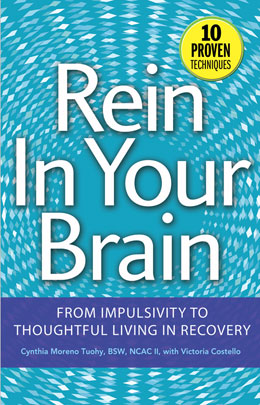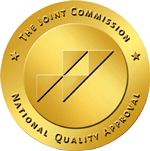
"Most people strive for healthy relationships but grow up without a gauge with which to recognize one when they see it—or are already in it."

Other titles you may like.
Visit Recovery Road to view and
listen to all the episodes.
Episode 94 -- March 8, 2021
The Wealth of Healthy Relationships
In the book, Rein In Your Brain, Cynthia Moreno Tuohy gives insightful guidance for how we can be more thoughtful in our daily lives. In this excerpt, she visits the topic of relationships and gives us examples of how to effectively determine the health of our personal relationships. When dealing with addiction, we often have a difficult time navigating relationships. In recovery, healthy relationships are a key factor that can aid in our journey to a more fulfilling life. This excerpt does a great job of detailing what is essential to building nourishing connections.
It has been edited for brevity.
What Does an Unhealthy Relationship Look Like?
Frequently, the dynamics from our family of origin prevent us from knowing the difference between healthy and unhealthy relationships in adulthood. Most people strive for healthy relationships but grow up without a gauge with which to recognize one when they see it—or are already in it. Often, overarching unhealthy behaviors learned in families are passed down from one generation to another. Here are some examples of unhealthy behaviors:
- The attempt to control what the other person does, who she sees, how he dresses, what she believes. Controlling another person is not necessary when and if you have common values and beliefs and you have made agreements regarding basic behaviors and boundaries. Controlling becomes a wedge in the relationship that eventually pushes the couple apart.
- Negative manipulation is another unhealthy behavior. "Positive manipulation" happens when you keep the best interests of another in mind. The problem occurs when manipulative behavior is not done for the highest good of the other person—when it meets the need of the manipulator instead. The other difference between the two is that positive manipulation is not pushed upon the other person; it is offered as an alternative or reasonable choice—choice being the operative word.
- A "you-owe-me" attitude also tears down a relationship. People develop this attitude based on what they have learned from family or society. It is a belief that one does something for someone else based solely on getting something from that person in return. This behavior does not take into consideration that a person may do something for another with no expectation of getting something in return. The difficulty with a you-owe-me attitude is that it is not always clear when someone has this expectation, nor when the person will require payment. It makes it hard to give or receive tokens of gratitude or affection without feeling like there are obligations involved. It is healthier to have such an agreement up front and out in the open.
What Does a Healthy Relationship Look Like?
Regardless of what role you may have adopted previously in relationship conflicts, at this point, I ask you to consider holding a new, healthy worldview. What would that be like? It would mean having a view of relationships that looks something like this:
- Being with someone—no matter what. This does not mean you agree to stay with a person who is mean, hateful, or hurtful. It does mean being in a relationship with the knowledge that there are going to be tough times, times when you will want to run, or times when your attention (or desire) wants to take you in other directions. You agree (within yourself and with your partner) that this is a person you are going to stick with, and find new ways to communicate and live with. You agree to dig deeper into the issues that build a wall between the two of you.
- We are interdependent on each other—interconnected. We need each other. This view recognizes that there are different ways to connect with others. We can be dependent on someone, we can be independent, or we can be interdependent, where we allow the influence of others as well as our own worldview to shape our lives. When we take an Interdependent stance in relationship, we recognize that, as human beings, we need each other. This does not mean we are weak or selfless. In healthy relationships, we change our focus from me to we and express this interrelatedness in thoughts, words, and behaviors.
- Relationships are entered into with heart and soul, without worrying about the outcome. You may have grown up learning that you must always have a "backup plan" in case the relationship does not work out. The difficulty with this way of thinking is that when we have a backup plan, we do not truly invest our all in the relationship. There are pieces held back or given in another direction, maybe to another person, and the primary relationship cannot be entered into with heart and soul. Many of us learned in our families of origin not to trust in a relationship because it will eventually fail, so we automatically put less energy into the relationship, thereby causing the relationship to fail due to lack of investment. Instead, in a healthy relationship, our thoughts move to thinking (and eventually believing) that this relationship will have a positive outcome!
- All you want is the other person's highest good.
This concept may sound counterintuitive. Your limbic may be screaming out "What about me? My highest good!" Not to worry, your limbic will be soothed by the positive results of thinking about another person's needs, because the reality is that your limbic will be on watch for you—even while your cortex is directing the action. We all tend to be me centered; now, we think in the direction of the other person and whether his or her highest good is being considered or factored into the relationship. This is especially helpful for the Avoider and Competer types among us, in that we have a tendency not to look toward the needs of others. (The Avoider tends not to look at his own needs, either.) - You are willing to do what is right to rescue the relationship.
To rescue is to throw out a lifeline when someone is drowning or to help a person who has no means to get out of a difficult situation. Of course, we like to think we would rescue someone in a life-threatening situation. But what about people in an emotionally or psychologically threatening situation? Are we as apt to assist them? Or do we stand to the side to measure what it means for us before we assist? In this alternative, healthier view of relationships, we operate on the premise that the relationship has value and so does the other person. We believe the person deserves our support and assistance in moving through a difficult emotional/ psychological situation. This does not mean we allow ourselves to be forever rescuing that person or giving of ourselves in a sacrificial manner. Balance is the key to this view, especially for the Accommodator, who tends to help others at the expense of his or her own needs. - It is not what happened, but what you do with what happened.
So often our limbic is stuck on what happened in a given situation, especially if it had a negative effect on us. Sometimes our reactions (avoid, accommodate, and compete) actually contribute to the negative effects of what happened. Nothing is really solved, blame and shame run high, and we all walk away from the situation feeling helpless and unable to solve the problem. In a healthier relationship stance, we take the view that negative things happen in life, even when we plan to make things positive. We believe that, together, we are going to find a way to move this negative situation to a more hopeful place. Approaching life and relationships with this view gives both people more power. - Doing all this means taking risks.
Yes, relationships are risky. You can get hurt. Yet the biggest danger you face is if you base the relationship on me. Throughout this book, we examine how easy it is to be me centered. Moving to we is a risk. It may also be new for us, making it unfamiliar and sometimes awkward. It takes time to train the brain to think and live in this way. Our task is to build a third reaction—beyond fight or flight. This third reaction requires that we stop in the moment of conflict and consider the we as a "center of gravity" from which all paths lead. - It requires the ability to forgive.
Being able to forgive is key to being happy with others and ourselves. Are there things in life that are hard to forgive and justify? Yes. There are things that seem larger than life or, in a word, unforgivable. It is our choice what we hold on to. We must decide what we wish to hold on to and what we will try to forgive. The more we can let go, the lighter our emotional/psychological load. We could spend the whole book on this issue alone; suffice it to say, forgiving is hard, but not letting go of hurt is harder still.
Healthy and Unhealthy Relationship Exercise
Think back on your significant past relationships. Make a table listing each relationship, its healthy qualities, and its unhealthy qualities. Consider the healthy qualities you want to add from the information you have learned thus far (e.g., resolving conflict by talking it through, listening with your heart, weekly date nights) and add those to your healthy qualities. Consider the unhealthy qualities you want to discard from your behaviors (e.g., jumping to conclusions, shouting your way through an argument, walking out the door in a huff, saying yes when you mean no) and make an agreement with yourself to work on letting those go.
Moving closer and more consistently to the healthy qualities will grow and mature you, causing you to be more content with yourself and others to be more content with you as well. Moving away from unhealthy behaviors will cause the same. Changing those specific behaviors through awareness and deliberate thoughtfulness are positive recovery processes to invest in that pay huge emotional rewards.
About the Author:
Cynthia Moreno Tuohy, BSW, NCAC II, is the executive director of NAADAC, the Association for Addiction Professionals. She previously served as the executive director of Danya Institute and the Central East Addiction Technology Transfer Center. Prior to this she was the program director for Volunteers of America-Western Washington, serving homeless populations and dealing with the co-occurrence of poverty and substance abuse issues. She has also written training components and manuals about working with adolescents, adults, and seniors; school intervention; involuntary commitment; community mobilization; intensive outpatient treatment and continuing care; the foundations of addiction practice; medication-assisted recovery; impaired driver programs; employee assistance programs; and gang intervention and treatment.
© 2014 by Cynthia Moreno Tuohy
All rights reserved Published 2014.




